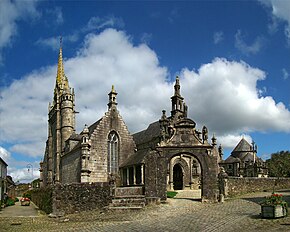Enclosed parish



An enclosed parish ( Breton liorzh-iliz , French enclos paroissial or an early church enclosure ) is a unique phenomenon in the sacred art of Europe and only occurs in this special form in Brittany .
description
An enclosed parish consists of the following elements:
- the cemetery and its sometimes quite high stone border,
- a triumphal gate that leads into the district,
- a charnel house ( Bret. karnel , French. ossuaire )
- the Calvaire ( Bret. Kalvar , French. calvaire ) and
- the church with an entrance hall in front.
The parish is a clearly delimited ensemble of coordinated buildings, the religious center of which is the Calvaire . The parish grounds are entered through the triumphal gate, often via a high stone slab that is set in vertically and can only be surmounted by a large step. It offers the dead protection from demons and eternal damnation and still makes it clear today that one is entering a special place. Ossuary emerged from the fact that the cemeteries were very limited in space. If they became too small, the bones of those who had long since died were dug up and kept in an ossuary.
The Calvaires are partly simple, partly complex monuments on square or round stone plinths, which are adorned with circumferential figure friezes. Above it rises the actual Calvary with the depiction of the crucifixion of Christ. Fully plastic figures populate the platform under the crosses. There are even figures on the cross beams. Due to the hard granite stone, they are mostly simply made. However, their facial expressions and the lively scenic design contribute to that fantastic effect that makes them an extraordinary phenomenon in Renaissance art.
background
The emergence of the parishes in the 16th and early 17th centuries and their concentration in the northern part of the Finistère department can be explained by the flourishing cloth trade in this region at the time , which brought prosperity even to small villages. About the port cities of Morlaix and Landerneau that led Weber from their linen fabrics. In an effort to visibly document the wealth that had been achieved, fierce competition broke out among the villages for the most magnificent parish.
The time of the creation of the enclosed parish districts coincides with the time of the Huguenot Wars . In the course of the Counter Reformation , the Catholic Church wanted to reaffirm its claim to power and leadership and therefore also used the magnificent buildings as a propaganda and advertising tool.
Examples
The most important enclosed parishes are in
- Argol
- Bodilis
- Commana
- Guimiliau
- Lampaul-Guimiliau
- La Martyre
- Pleyben
- Plougastel daoulas
- Plougonven
- Runan
- Saint-Suliac
- Saint-Thégonnec
- Sizun
literature
- Guy Leclerc: Les enclos de Dieu. Éditions Jean-Paul Gisserot 1996, ISBN 978-2-87747-244-9
- Yannick Pelletier: Les enclos bretons. Editions Jean-Paul Gisserot 2003, ISBN 978-2-87747-029-2